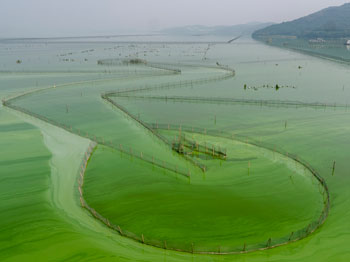Algae Blooms, Lake Tai, Jiangsu Province, China

George Steinmetz photo.
A system of poles and nets are remnants of bygone fish habitat in China’s third largest lake (869 sq. miles). Thirty years ago the waters of Lake Tai were clear of algae. In that time high density cities around the lake have grown rapidly. Livestock drainage, agricultural practices and sewer dumping have combined to let the algae flourish. Global warming and poor management have established the algae blooms. The blooms have covered much larger areas in the last decade and their season is longer. Green slime was coming out of the faucets in the cities surrounding the lake in 2007. Two million people were without drinking water. The government had to bring in water.
This photograph was published with an article in the New York Times titled “Losing Earth: The Decade We Almost Stopped Climate Change” by Nathaniel Rich. It is the only article in the Sunday New York Times Magazine for August 5, 2018. The focus is the research of leading scientists going back to the 1960s.
Their conclusion was that something had to be done immediately to stop climate change. Others agreed and worked toward that goal. What happened? It’s in what may be one of the most informative, substantive, and well-written articles on the most important topic of our time.
READ: “Losing Earth: The Decade We Almost Stopped Climate Change”
